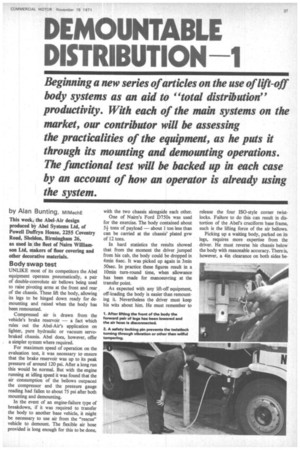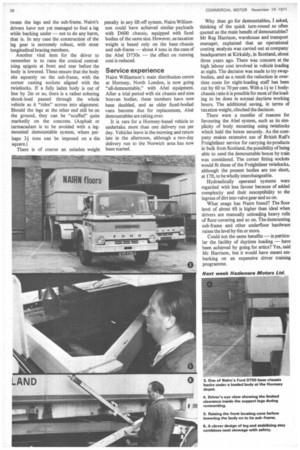DISTRIBUTION -1
Page 35

Page 36

If you've noticed an error in this article please click here to report it so we can fix it.
Beginning a new series of articles on the use of lift-off body systems as an aid to "total distribution" productivity. With each of the main systems on the market, our contributor will be assessing the practicalities of the equipment, as he puts it through its mounting and demounting operations.
The functional test will be backed up in each case by an account of how an operator is already using the system.
by Alan Bunting, MIMechE This week, the Abel-Air design produced by Abel Systems Ltd, of Powell Duffryn House, 2255 Coventry Road, Sheldon, Birmingham 26, as used in the fleet of Nairn Williamson Ltd, makers of floor covering and other decorative materials.
Body swap test
UNLIKE most of its competitors the Abel equipment operates pneumatically, a pair of double-convolute air bellows being used to raise pivoting arms at the front and rear of the chassis. These lift the body, allowing its legs to be hinged down ready for demounting and raised when the body has been remounted.
Compressed air is drawn from the vehicle's brake reservoir — a fact which rules out the Abel-Air's application on lighter, pure hydraulic or vacuum servobraked chassis. Abel does, however, offer a simpler system where required.
For maximum speed of operation on the evaluation test, it was necessary to ensure that the brake reservoir was up to its peak pressure of around 120 psi. After a long run this would be normal. But with the engine running at idling speed it was found that the air consumption of the bellows outpaced the compressor and the pressure gauge reading had fallen to about 75 psi after both mounting and demounting.
In the event of an engine-failure type of breakdown, if it was required to transfer the body to another base vehicle, it might be necessary to use air from the "rescue" vehicle to demount. The flexible air hose provided is long enough for this to be done, with the two chassis alongside each other.
One of Nairn's Ford D750s was used for the exercise. The body contained about 5+ tons of payload — about 1 ton less than can be carried at the chassis' plated gvw of 12 tons.
In hard statistics the results showed that from the moment the driver jumped from his cab, the body could be dropped in 4min 6sec. It was picked up again in 3min 50sec. In practice these figures result in a lOrnin turn-round time, when allowance has been made for manoeuvring at the transfer point.
As expected with any lift-off equipment, off-loading the body is easier than remounting it. Nevertheless the driver must keep his wits about him. He must remember to release the four ISO-style corner twistlocks. Failure to do this can result in distortion of the Abel's cruciform base frame, such is the lifting force of the air bellows.
Picking up a waiting body, parked on its legs, requires more expertise from the driver. He must reverse his chassis below the body with reasonable accuracy. There is, however, a 4in clearance on both sides be tween the legs and the sub-frame. Nairn's drivers have not yet managed to foul a leg while backing under — not to do any harm, that is. In any case the construction of the leg gear is extremely robust, with stout longitudinal bracing members.
Another vital item for the driver to remember is to raise the conical centralizing spigots at front and rear before the body is lowered. These ensure that the body sits squarely on the sub-frame, with the corner casting sockets aligned with the twistlocks. If a fully laden body is out of line by 2in or so, there is a rather sobering shock-load passed through the whole vehicle as it "rides" across into alignment. Should the legs at the other end still be on the ground, they can be "scuffed" quite markedly on the concrete. (Asphalt or tarmacadam is to be avoided with a legmounted demountable system, where perhaps 24 tons can be imposed on a 6in square.) There is of course an unladen weight penalty in any lift-off system. Nairn Williamson could have achieved similar payloads with D600 chassis, equipped with fixed bodies of the same size. However, as taxation weight is based only on the base chassis and sub-frame — about 4 tons in the case of the Abel D750s — the effect on running cost is reduced.
Service experience
Nairn Williamson's main distribution centre at Hornsey, North London, is now going "all-demountable," with Abel equipment_ After a trial period with six chassis and nine boxvan bodies, these numbers have now been doubled, and as older fixed-bodied vans become due for replacement, Abel demountables are taking over.
It is rare for a Hornsey-based vehicle to undertake more than one delivery run per day. Vehicles leave in the morning and return late in the afternoon, although a two-day delivery run to the Norwich area has now been started. Why then go for demountables, I asked, thinking of the quick turn-round so often quoted as the main benefit of demountables? Mr Reg Harrison, warehouse and transport manager, explained that an operational costing analysis was carried out at company headquarters at Kirkaldy, in Scotland, about three years ago. There was concern at the high labour cost involved in vehicle loading at night. The decision was made to try swapbodies, and as a result the reduction in overtime costs for night-loading staff has been cut by 60 to 70 per cent. With a 14 to 1 body: chassis ratio it is possible for most of the loading to be done in normal daytime working hours. The additional saving, in terms of taxation weight, clinched the decision.
There were a numher of reasons for favouring the Abel system, such as its simplicity of body mounting using twistlocks which held the boxes securely. As the company makes extensive use of British Rail's Freightliner service for carrying its-products in bulk from Scotland, the possibility of being able to send the demountable boxes by train was considered. The corner fitting sockets would fit those of the Freightliner twistlocks, although the present bodies are too short, at 17ft, to be wholly interchangeable.
Hydraulically operated systems were regarded with less favour because of added complexity and their susceptibility to the ingress of dirt into valve gear and so on.
What snags has Nairn found? The floor level of about 4ft is higher than ideal when drivers are manually unloacling heavy rolls of floor-covering and so on. The demounting sub-frame and other underfloor hardware raises the level by 6in or more.
Could not the same benefits — in particular the facility of daytime loading — have been achieved by going for artics? Yes, said Mr Harrison, but it would have meant embarking on an expensive driver training programme.




















































































































